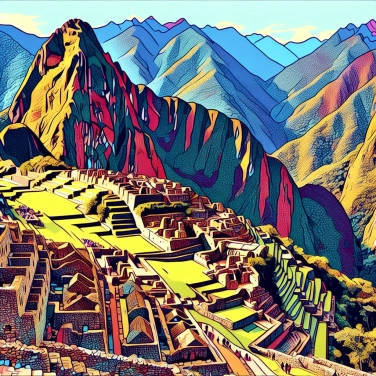The site of Machu Picchu intrigues archaeologists due to its isolated and hard-to-access location in the Andes, raising questions about its precise function and how construction materials were transported. Additionally, the complex architecture and advanced construction techniques, such as mortarless assembly, continue to inspire research to better understand the skills and knowledge of the Incas.

Built around the 15th century during the reign of Emperor Pachacutec, Machu Picchu remains unclear about its exact origin. Some say it was a religious sanctuary, others suggest it might have been a royal retreat or even a strategic city. There are no written texts to clearly explain, just theories based on the remnants found. The site may have accommodated a small elite with specific functions: religious, administrative, or simply symbolic. The lack of direct clues about its initial role continues to intrigue archaeologists around the world today.
Machu Picchu fascinates because it was built with astonishing precision without modern tools, wheels, or mortar. The stones, some weighing several tons, are assembled so precisely that it is impossible to slip a knife blade between them. One still wonders how the Incas moved these gigantic blocks to the top of such a steep mountain without draft animals. They used an ingenious method called polygonal stone cutting, allowing the structures to withstand earthquakes better than many modern buildings. Another mystery is their ability to accurately orient certain buildings according to astronomical phenomena, such as the sun during solstices and equinoxes, without technology to precisely measure angles. These incredible technical achievements make the site both impressive and intriguing.
Machu Picchu is perched high in the mountains, but that didn't stop the Incas from being pros at agriculture. They created stepped agricultural terraces on the mountainsides to cultivate efficiently even at high altitudes. These terraces also prevent the soil from sliding during heavy rains and retain moisture well. On the water front, they devised a highly clever network of irrigation channels and fountains, fed by a natural spring located higher up. This ingenious system distributed fresh, clean water throughout the site, precisely controlling the flow. Even today, this water network intrigues researchers with its efficiency, robustness, and especially the technical finesse used by the Incas, without any metal or modern technology.
The spirituality of the Incas is a sacred mystery: they viewed the world through a subtle balance linked to nature, the stars, and ancestors. The site of Machu Picchu intrigues because worship or ceremonial places have been found there, such as the famous Intihuatana, a stone used to capture the passage of the sun on specific dates. But frankly, we still know very little about how their daily rituals actually took place and why certain spaces seem so precisely oriented towards astronomical phenomena. For example, there were surely very codified ceremonies, but many details or their precise meanings remain unknown. Archaeologists are still scratching their heads: what exactly were their main gods here, and what specific symbols were hidden behind their ceremonies? We know of their immense respect for Inti, the sun god, and Pachamama, Mother Earth. Yet, specific areas of the site, clearly religious in purpose, still keep their secrets.
In recent years, new technologies like laser scanners and thermal imaging drones have made it possible to detect structures previously hidden under the dense vegetation around the Machu Picchu site. New Inca trails and even ruins of previously unknown buildings have recently been identified. These discoveries raise quite a few questions about the true extent and precise function of the city. Similarly, recent analyses of bones found on site challenge archaeologists: Did Machu Picchu also serve as a more significant sacrificial or funerary site than initially imagined? These advancements are intriguing but clearly show that this mythical site is far from having revealed all its secrets.
Contrary to popular belief, Machu Picchu is not the lost city of the Incas (known as Vilcabamba); the latter is actually thought to be located elsewhere in the Peruvian jungle.
Although it is situated at an altitude of over 2,430 meters, Machu Picchu is protected from earthquakes thanks to its walls made of perfectly interlocking stones, without mortar.
The famous term 'Machu Picchu' literally means 'old mountain' in the Quechua language, the one spoken by the Incas.
The site has approximately 600 agricultural terraces, which were used to stabilize the soil and grow various crops such as corn and potatoes at high altitude.
One of the incredible features of the site is the ingenious precaution used by the Incas to reinforce the structures against earthquakes. They employed highly advanced seismic masonry techniques, such as the assembly of perfectly fitted stones, which partially explains the remarkable preservation of the site today.
Sure! Here’s the translation: "Yes and no. Machu Picchu was forgotten by the international public until 1911, when it was revealed by the American explorer Hiram Bingham. The locals had known about the existence of the site for a long time, but without widely spreading this information. Since this media rediscovery, the site has regularly been the subject of excavations and further research."
Yes, it is generally accepted that Machu Picchu held great spiritual and sacred significance for the Incas. However, the exact details of the rituals performed and their meanings remain largely unknown, thus fueling many hypotheses and archaeological research.
Although research has been conducted, the complete absence of iron tools, wheels, or other modern technologies makes it difficult to definitively understand the precise methods used by the Incas to carve, transport, and assemble enormous rock blocks with extreme precision.
The site of Machu Picchu continues to intrigue archaeologists due to numerous uncertainties regarding its exact function, its incredibly advanced construction methods, its sophisticated irrigation systems, as well as the mysteries surrounding the Inca rituals practiced on site.
Yes, archaeological research at Machu Picchu is still ongoing. Regularly, recent discoveries open new perspectives on the daily life of the Incas and raise new questions that continuously stimulate international interest in the site.

No one has answered this quiz yet, be the first!' :-)
Question 1/7